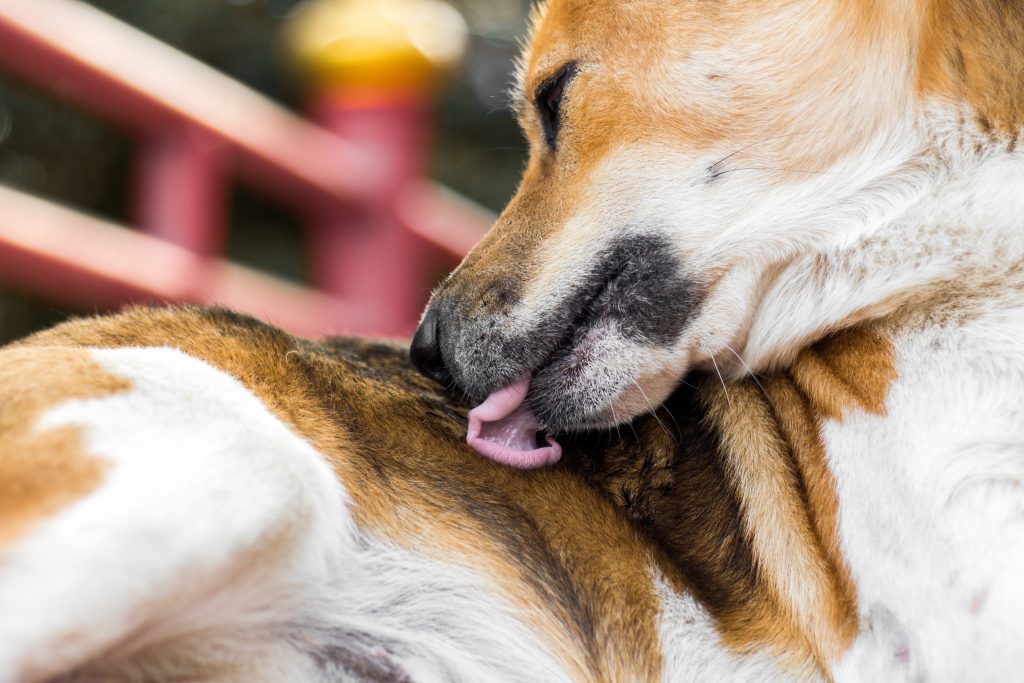
What is Acute Moist Dermatitis AKA Hot Spots?
Acute moist dermatitis, best known as hot spots, is one of the most common skin conditions among dogs. Hot spots are localized areas of skin inflammation and infection. These often appear as moist, red, hot lesions on the dog’s legs, paws, chest, head, or hip area.
Many hot spots will begin small enough that owners may mistake them for a bug bite. These lesions are incredibly itchy and painful. As the dog licks, scratches, and bites at the area, the infection can spread and continue to worsen.
Causes of Hot Spots
Several things can cause irritation and lead a dog to lick, scratch, or chew at that irritation excessively. The most common contributing factor for hot spots is bacteria — moisture and irritated skin create the ideal environment for bacteria to grow.
Some common triggers identified by AKC include:
- Allergies: Food and environmental allergies can both cause excessive itching in dogs.
- Pyoderma: This means “pus in the skin” or bacterial infections of the skin. Primary skin infections caused by yeast or bacteria can cause severe itching, which often leads to secondary hot spots.
- Pests: Insect bites can be so annoying for both people and dogs alike. Fleas, ticks, mosquitoes, and other small insect bites can cause skin irritation and itching.
- Ear Infections: Yeast or bacteria within the ear canal can cause dogs to scratch at the area surrounding the ears.
- Poor Grooming: Dogs that are not groomed regularly can develop tangled or matted hair, which can lead to moisture retention and ultimately, bacterial infections.
- Anal Gland Issue: A dog’s anal glands can become impacted or infected, causing the area to become painful and uncomfortable, resulting in excessive licking.
- Moisture & Humidity: Hot spots are much more likely to occur during warm and humid weather. Excess moisture within the dog’s coat caused by bathing or swimming can also lead to hot spots.
- Behavioral Problems: Sometimes dogs lick themselves due to stress, boredom, or other behavioral or attention-seeking issues.
Signs of Hot Spots in Dogs
Because excessive itching tends to contribute to the rapid spread of infection, hot spots often grow at a fast rate over a short timeframe. Fortunately, there are many symptoms and signs of acute moist dermatitis you can look out for, including:
- Inflammation
- Redness
- Pain
- Itching
- Oozing
- Warm to touch
- Bad odor
- Excessive scratching
- Hair loss
Healing Hot Spots in Dogs
Because these inflamed spots can worsen so quickly, healing hot spots in dogs ASAP is essential. While some hot spots can be treated at home, the underlying cause should always be identified by a licensed veterinarian to prevent further infection.
It’s especially critical to seek medical assistance if you’re unable to keep your pet from licking/scratching or if the affected area is:
- Increasing in size
- Constantly bleeding
- Displaying any colored discharge
Depending on the severity, your veterinarian may treat the area with a combination of things such as antibiotics or anti-itch medication. Depending on the cause, additional treatment may be necessary, such as flea/tick prevention, long-term allergy medication, ear medication, and more.
If you’re unable to get to the vet right away, PetMD shared some steps you can try at home to help heal your pet’s hot spots in the meantime.
- Trim the area around the hot spot with dog hair clippers (not scissors). This will allow the affected area to get some air, and prevent excess moisture from slowing the healing process.
- Clean the skin with a mild, dog-safe, water-based antiseptic spray or wipe, or an antibacterial shampoo.
- Apply a veterinary-recommended hot spot treatment spray that is safe if ingested.
- Place an e-collar, or “the cone of shame,” on your dog to help prevent them from biting, licking, or scratching the hot spot.
- Monitor the area for improvement and signs of healing (decreased redness, less moisture, smaller lesion size).
Note: Human medications such as Neosporin, hydrocortisone, and Vaseline should NOT be used. Topical creams and ointments tend to cause dogs to lick the area even more, so they should be avoided if possible.
In some cases, you can help at home by treating your dog to regular flea prevention, regular grooming (especially after swimming), preventing ear infections by administering maintenance ear cleansers, and treating allergies if need be. Additionally, try to avoid boredom. Decrease excess licking behaviors by providing your pet with interactive toys. Finally, the key to healing hot spots in dogs or preventing further acute moist dermatitis is determining the underlying cause. Consult with your veterinarian or visit one of our 21 Arizona PetVet locations closest to you.
Disclaimer: Not intended to be a substitute for professional veterinarian advice, diagnosis, or treatment. Always seek the advice of your veterinarian with any questions you may have regarding the medical condition of your pet. If you think your pet has a medical emergency, call or visit your veterinarian or your local veterinary emergency hospital immediately.

